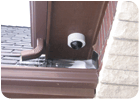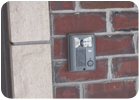
A video surveillance camera provides a view of the gate area
in this brick wall that can be viewed remotely before it is opened. The video
installation is by Home Technology Systems, Wichita,
Kan.
Many installing dealers that specialize in the custom home market are slow to embrace the opportunities that await them in residential IP video surveillance. The most obvious reason is the daunting learning curve that comes along with it.
“The real challenge in entering this market is learning IP technology -- you have to understand it,” emphasizes Andrew Elio, president of All Ways Safe Security Inc., Westchester, N.Y. Elio does understand it, and that savvy has afforded him significant work in residential IP.
He contends, “If you know IP technology, working in this market is not a problem. But your typical CCTV installer is not going to walk into this application and wing it if they don’t know certain protocols.
“If you understand the technology, it’s a good field to be in,” he adds. “But a lot of people just don’t yet, and that’s where the problem is. More things are becoming IP-addressable, IP-capable and wireless-ready. Those in the traditional security industry will eventually have to migrate to this.”
Elio, whose company has additional offices in the Bronx, N.Y., and Newtown, Conn., is testament to the fact that for those willing to brave the new technological frontier, the journey can be well worth it. The customers are out there, Elio says.
“There is a definite demand,” he insists. “Homeowners are looking to put their minds at ease, and they’re looking to IP video surveillance to do it.”
About 25 percent of his IP business is derived from architects, general contractors and builders, with the remaining 75 percent being driven by customers ranging from one-bedroom apartment dwellers to owners of million-dollar homes. The needs are as varied as the installation budgets.
“Typically, the folks in the million-dollar homes have a nanny they want to check on, while the guy in the apartment wants to make sure no one is coming in the fire escape window,” Elio notes. The circumstances may be different, but the objective is the same. “They all want to be able to look into the camera to check on things and put their minds at ease,” he maintains.

Domes can be placed around homes in unobtrusive locations
such as this soffit. All cameras are
connected to a multichannel IP-based DVR for viewing remotely in this
installation by Home Technology Systems.
KEEP THE CUSTOMERS SATISFIED
Peace of mind at a distance is what customers of Stephen Duby, president of Easy Tech Connections, Lake Havasu City, Ariz., are seeking. “Security seems the biggest driver in our community,” he notes. “A great many of the homes here are winter or vacation homes and remain vacant at least half the year. Consequently, owners want to keep an eye on their property.”Interestingly, Duby notes, clients with second homes in Lake Havasu City are attracted to IP not only for the security aspects. “It’s a beautiful place to live, and having a camera outside your home or property makes it a showplace from any desktop computer connected to the Web,” he points out. “Their rationale is always security, but I’m sure clients are saying to fellow workers or associates, ‘Hey did I ever show you my home in Lake Havasu? Check out the lake from my patio cam.’”
Easy Tech Connections draws many of its customers from word of mouth as well as encouraging its salespeople and installers to talk about IP camera surveillance when they are on a job site, regardless of why they are out seeing the client.
In his Arizona market, Duby primarily is seeing owners of homes valued at $500,000 or more purchasing IP surveillance systems. The cost of the systems he is selling range from $2,000 to $25,000.
The homeowners are recording and monitoring their video surveillance on and off-site. Internet-ready DVRs are asked for most frequently, and night-sight capabilities also are requested often, Duby reports, because of the lack of street lights where they are located.
Location may have a lot to do with consumer demand. Shannon McGinnis, president and owner of Home Technology Systems, Wich-ita, Kan., reports, “We’re in the midsection [of the country], and while we do high-end integration, we’re in an immature market in Wichita compared to New York or California. But we are seeing more requests for recording in home cameras for security purposes and remote monitoring.”
To drive those requests, McGinnis markets through a local builders’ association magazine and also gets a good amount of referrals. With five installers and four vans, Home Technology Systems has been doing front-door camera installs for years, and the transition to IP was a smooth one.
McGinnis concedes that doing commercial applications before the emergence of residential surveillance played a part in that. “I think a willingness to approach this market really depends on an individual dealer’s background,” McGinnis believes. “If they didn’t get into audio or structured cabling because they were apprehensive, IP could be alongside that.”

This intercom has a camera that can transmit a photo of the
visitor to a DVR inside.
TREADING NEW WATERS: SINK OR SWIM
The decision to work within this market, McGinnis believes, comes down to someone’s particular business mission and sales approach.“Dealers could certainly sweeten the pot by doing other types of installs,” McGinnis thinks. “Our motto is if we go out to do security for a customer, we immediately ask them what they’re doing for the telephone, audio, data, etc.
“We’re always looking to expand our scope of services, and for us it’s not a scary thing,” he stresses. “But I can understand that it could be for someone else who hasn’t.”
Preparing to offer residential IP video surveillance soon is Guardian Protection Service, Warrendale, Pa. Nick Blodis, a regional district manager for Guardian, says, “Our thoughts are we’d like to provide real-time video and storage video archived for event-driven capability.
“What’s driving this market is the fact that people want to know what’s going on in their residences while they’re away, particularly people having services done in their homes while they’re gone by nannies or housekeepers,” he emphasizes. “Some surveillance is event-driven; when kids come home, parents can get an e-mail or text message notification and go to the Web site to see what’s going on.”
Although some customers with deep pockets opt for high-end, sophisticated systems, Blodis feels that most people just want to have access to clear video. “Previous systems had refresh rates that were pretty poor,” he admits. “But now with broadband access and better technologies on either a DVR or off-site service, the technology is there and will be accepted in the marketplace from a quality standpoint.”
Because customers need to have broadband Internet access to take advantage of their IP systems, dealers working in remote areas should confirm that customers have access to cable modems or fiber optics.
These pioneering installers are riding the new wave of residential IP video surveillance success and encourage fellow dealers to at least try to get their feet wet.
“If you can get into this niche, now is a good time,” Elio advises. “It’s getting good and it’s getting cost-effective to do it.”
To put yourself on the IP path, avail yourself of all the education you can. Many manufacturers offer product training as do their distribution partners. There is no time like the present to prepare for the future and make yourself at home in the residential IP video surveillance market.
Sidebar: Picking Out Product
As far as the products and components that go into an installation, Andrew Elio, president of All Ways Safe Security Inc., says it depends on the application, but notes that if there is not a router out of the box, he gets a 4- and 8-channel router to put from four to eight cameras into each.For a typical two-camera Web-based application, Nick Blodis, a regional district manager for Guardian Protection Service, Warrendale, Pa., does not consider having a hard drive on-site. “We’re more in tune with the remote, off-site service providers that would store the video for a certain period of time offsite, giving the customer more of a gateway than a hard drive storage place at home,” Blodis explains.
In terms of cameras, DVRs, monitors and cabling connectors, Stephen Duby, president of Easy Tech Connections, Lake Havasu City, Ariz., adds that because brands vary and the market is changing so quickly, he shops parts from different vendors for almost every job.
“We would love to settle on one or two suppliers, but we haven't found them yet,” he laments. Regardless of an installer’s product of choice or a lack of one, the technologies, methods and prices are being driven down, Blodis asserts, and will get more widely accepted just like any other newly emerging technology.